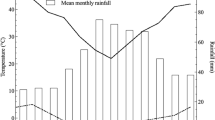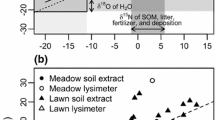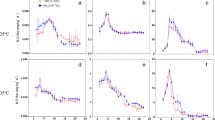Abstract
Nine independent experiments of NO3 − denitrification were analysed using the Arrhenius law and the Eyring’s transition-state theory to highlight how temperature affects reaction rate constants, affinities, and kinetic isotopic effects. For temperatures between 20 and 35 °C, the Arrhenius law and the transition-state theory described equally well observed temperature increases in 14NO3 − and 15NO3 −denitrification rates (R > 0.99 and residuals NRMSE < 3.39 %, p < 0.01). These increases were partly caused by an increase in frequency factor and a slight decrease in activation energy (enthalpy and entropy). Parametric analysis also showed that the affinity of 14NO3 − and 15NO3 − toward a microbial enzyme increased exponentially with temperature and a strong correlation with the rate constants was found (R = 0.93, p < 0.01). Experimental time- and temperature-averaged fractionation factor α P/S showed only a slight increase with increasing temperature (i.e. lower isotopic effects); however, a comprehensive sensitivity analysis in the concentration-temperature domain using average thermodynamic quantities estimated here showed a more complex response; α P/S was relatively constant for initial bulk concentrations [NO3 −]0 ≤ 0.01 mol kg−1, while substantial nonlinearities developed for [NO3 −]0 ≥ 0.01 mol kg−1 and appeared to be strongly correlated with microbial biomass, whose concentration and activity varied primarily as a function of temperature and available substrate. Values of α P/S ranging between 0.9 and 0.98 for the tested temperatures suggested that interpretations of environmental isotopic signatures should include a sensitivity analysis to the temperature as this affects directly the rate constants and affinities in biochemical reactions and may hide process- and source-related isotopic effects.







Similar content being viewed by others
Abbreviations
- α :
-
Fractionation factor (–)
- δ :
-
Isotopic composition (–)
- x, y:
-
Stoichiometric coefficients (–)
- G :
-
Gibbs free energy (J mol−1)
- h :
-
Planck constant (J s)
- H :
-
Heat content (J mol−1)
- k :
-
Reaction rate constant (Τ−1)
- K b :
-
Boltzmann constant (J K−1 mol−1)
- K :
-
Affinity (half-saturation concentration) (M)
- S :
-
Entropy content (J K−1 mol−1)
- t :
-
Time (T)
- T :
-
Absolute temperature (K)
- NRMSE:
-
Normalized root mean square error (–)
- R:
-
Correlation coefficient (–)
References
Andersen E, Jul M, Riemann H (1965) Industriel levnedsmiddelkonservering, 2. Kuldekonservering, Teknisk Forlag, Copenhagen (In Danish)
Atkins P, de Paula J (2006) Physical chemistry, 8th edn. W.H. Freeman & Co., New York, p 1053
Batchelor B, Lawrence AW (1978) Autotrophic denitrification using elemental sulfur. J WPCF 50(8):1986–2001
Bell RM, Parsons SM, Dubravac SA, Redfield AG, Koshland DE (1974) Characterization of slowly interconvertible states of phosphoribosyladenosine triphosphate synthetase dependent on temperature, substrates, and histidine. J Biol Chem 249:4110–4118
Blackmer AM, Bremner JM (1977) Nitrogen isotope discrimination in denitrification of nitrate in soils. Soil Biol Biochem 9(73):73–77
Briggs GE, Haldane JBS (1925) A note on the kinetics of enzyme action. Biochem J 19(2):338–339
Chien SS, Shearer G, Kohl DH (1977) The nitrogen isotope effect associated with nitrate and nitrite loss from waterlogged soils. Soil Sci Soc Am J 41:1977
Davidson EA, Samanta S, Caramori SS, Savage K (2012) The Dual Arrhenius and Michaelis-Menten kinetics model for decomposition of soil organic matter at hourly to seasonal time scales. Glob Change Biol 18:371–384. doi:10.1111/j.1365-2486.2011.02546.x
Doerthy J (2004) PEST Model-independent parameter estimation, 5th Ed
Droop MR (1968) Vitamin B1 and marine ecology. IV. The kinetics of uptake, growth and inhibition in Monochrysis lutheri. J Mar Biol Assoc UK 48:689–733
Elsner M, Zwank L, Hunkeler D, Schwarzenbach RP (2005) A new concept linking observable stable isotope fractionation to transformation pathways of organic pollutants. Environ Sci Technol 39:6896–6916
Eyring H, Magee JL (1942) Application of the theory of absolute reaction rates to bacterial luminescence. J Cell Comp Physiol 20(2):169–177
Eyring H, Gershinowitz H, Sun CE (1935) The absolute rate of homogeneous atomic reactions. J Chem Phys 3:786. doi:10.1063/1.1749593
Fosling ML, Widdas WF (1968) The effect of temperature on the competitive inhibition of glucose transfer in human erythrocytes by phenolphthalein, phloretin and stilboestrol. J Physiol 194:545–554
Gastrin B, Kallings LO, Marcetic A (1968) The survival time for different bacteria in various transport media. Acta Pathol Microbiol Scandinav 74:371–380
Glasstone S, Laidler KJ, Eyring H (1941) The theory of rate processes, 1st edn. McGraw-Hill, New York, p 611
Grant RF, Pattey E, Goddard TW, Kryzanowsky LM, Puurveen H (2006) Modeling the effect of fertilizer application rate on nitrous oxide emissions. Soil Sci Soc Am J 70:235–248
Gu C, Maggi F, Riley WJ, Hornberger GM, Xu T, Oldenburg CM, Spicher N, Miller NL, Venterea RT, Steefel C (2009) Aqueous and gaseous nitrogen losses induced by fertilizer application. J Geophys Res 114:G01006. doi:10.1029/2008JG000788
Haldane JBS (1930) Enzymes. Longmans, Green & Co., London
Hunkeler D, Aravena R (2000) Evidence of substantial carbon isotope fractionation among substrate, inorganic carbon, and biomass during aerobic mineralization of 1,2-Dichloroethane by Xanthobacter autotrophicus. Appl Environ Microbiol 66(11):4870–4876
Knowles R (1982) Denitrification. Microbiol Rev 46(1):43–70
Kooijman SALM (1998) The synthesizing unit as model for the stoichiometric fusion and branching of metabolic fluxes. Biophys Chem 73:179–188
Kooijman SALM (2010) Dynamic energy budget theory for metabolic organisation, 3rd edn. Cambridge University Press, Amsterdam
Laidler KJ (1958) The chemical kinetics of enzyme action. Clarendon, Oxford, pp 30–38
Laidler KJ (1963) Reaction kinetics: volume ll-reactions in solution. Pergamon Press, Oxford
Laidler KJ (1978) Physical chemistry with biological applications. Benjamin/Cummings Pub. Co., Menlo Park, p 587
Larionova AA, Yevdokimov IV, Bykhovets SS (2007) Temperature response of soil respiration is dependent on concentration of readily decomposable C. Biogeosciences 4:1073–1081
Maggi F, Porporato A (2007) Coupled moisture and microbial dynamics in unsaturated soils. Water Resour Res 43:W07444. doi:10.1029/2006WR005367
Maggi F, Riley WJ (2009) Transient competitive complexation in biological kinetic isotope fractionation explains non-steady isotopic effects: theory and application to denitrification in soils. J Geophys Res. doi:10.1029/2008JG000878
Maggi F, Riley WJ (2010) Mathematical treatment of isotopologue and isotopomer speciation and fractionation in biochemical kinetics. Geochim Cosmochim Acta 74:1823
Maggi F, Gu C, Riley WJ, Hornberger GM, Venterea RT, Xu T, Spicher N, Steefel C, Miller NL, Oldenburg CM (2008) A mechanistic treatment of the dominant soil nitrogen cycling processes: model development, testing, and application. J Geophys Res 113:G02016. doi:10.1029/2007JG000578
Mariotti A, Germon JC, Hubert P, Kaiser P, Letolle R, Tardieux A, Tardieux P (1981) Experimental determination of nitrogen kinetic isotope fractionation: some principles; illustration for the denitrification and nitrification processes. Plant Soil 62(3):413–430
Mathieu O, Leveque J, Henault C, Ambus P, Milloux MJ, Andreux F (2007) Influence of 15 N enrichment on the net isotopic fractionation factor during the reduction of nitrate to nitrous oxide in soil. Rapid Commun Mass Spectrom 21:1447
Menyailo OV, Hungate BA (2006) Stable isotope discrimination during soil denitrification: production and consumption of nitrous oxide. Global Biogeochem Cycles. doi:10.1029/2005GB002527
Michaelis L, Menten M (1913) Biochem Z 49:333, translation into English by R.S. Goody and K.H. Johnson
Muller S, Strous M (2011) Continuous cultivation and thermodynamic aspects of niche definition in the nitrogen cycle, chapter 2. In: Abelson JN, Simon MI (eds) Methods in enzymology, 1st edn. Elsevier, US, p 33
Perez T, Garcia-Montiel D, Trumbore S, Tyler S, De Camargo P, Moreira M, Piccolo M, Cerri C (2006) Nitrous oxide nitrification and denitrification 15 N enrichment factors from amazon forest soils. Ecol Appl 16(6):2153–2167
Raey D, Nedwell DB, Priddle J, Ellis-Evans JC (1999) Temperature dependence of inorganic nitrogen uptake: reduced affinity for nitrate at suboptimal temperatures in both algae and bacteria. Appl Environ Microbiol 65(6):2577–2584
Ribbe M, Gadkari D, Meyer O (1997) N2 fixation by Streptomyces thermoautotrophicus involves a molybdenum-dinitrogenase and a manganese-superoxide oxidoreductase that couple N2 reduction to the oxidation of superoxide produced from O2 by a molybdenum-CO dehydrogenase. J Biol Chem 272(42):26627–26633
Riley WJ, Maggi F, Kleber M, Torn MS, Tank JY, Dwivedi D, Guerry N (2014) Long residence times of rapidly decomposable soil organic matter: application of a multi-phase, multi-component, and vertically-resolved model (TOUGHREACTv1) to soil carbon dynamics. Geoscientific Model Development Discussion 7:815–870. doi:10.5194/gmdd-7-815-2014
Salem S, Moussa MS, van Loosdrecht MCM (2005) Determination of the decay rate of nitrifying bacteria. Biotechnol Bioeng 94(2):252–262. doi:10.1002/bit.20822
Shearer G, Kohl DH (1988) Nitrogen isotopic fractionation and 18O exchange in relation to the mechanism of denitrification of nitrite by Pseudomonas stutzeri. J Biol Chem 263(26):13231–13245
Sprent J (1987) The ecology of the nitrogen cycle. Cambridge Univ. Press, New York
Strohm TO, Griffin B, Zumft WG, Schink B (2007) Growth yield in bacterial denitrification and nitrate ammonification. Appl Env Microbiol 73:1420
Tang FHM, Maggi F (2012) The effect of 15 N to 14 N ratio on nitrification, denitrification and dissimilatory nitrate reduction. Rapid Commun Mass Spectrom 26(4):430–442. doi:10.1002/rcm.6119
Tang JY, Riley WJ (2013) A total quasi-steady-state formulation of substrate uptake kinetics in complex networks and an example application to microbial litter decomposition. Biogeosciences 10:8329–8351
Tang JY, Riley WJ (2014) Weaker soil carbon-climate feedbacks resulting from microbial and abiotic interactions. Nature Climate Change (accepted, in press)
Tortora GJ, Funke BR, Case CL (2007) Microbiology: an introduction. Pearson Benjamin Cummings, San Francisco
van Breukelen BM (2007) Extending the Rayleigh equation to allow competing isotope fractionating pathways to improve quantification of biodegradation. Environ Sci Technol 41:4004–4010
Winzor DJ, Jackson CM (2006) Interpretation of the temperature dependence of equilibrium and rate constants. J Mol Recognit 19:389–407
Author information
Authors and Affiliations
Corresponding author
Additional information
Responsible Editor: Karsten Kalbitz.
Rights and permissions
About this article
Cite this article
Maggi, F., Riley, W.J. The effect of temperature on the rate, affinity, and 15N fractionation of NO3 − during biological denitrification in soils. Biogeochemistry 124, 235–253 (2015). https://doi.org/10.1007/s10533-015-0095-2
Received:
Accepted:
Published:
Issue Date:
DOI: https://doi.org/10.1007/s10533-015-0095-2




